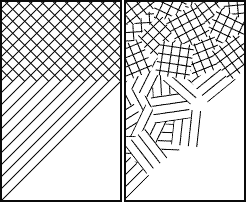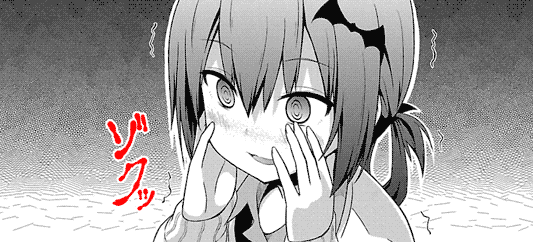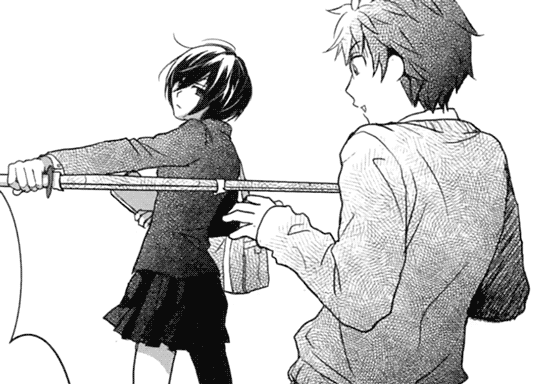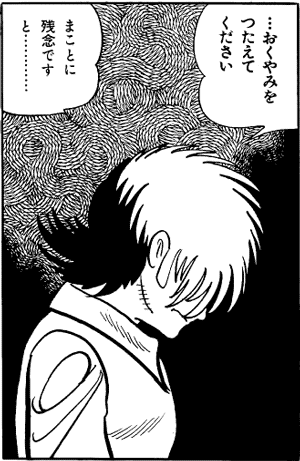For example, in the panel below, the top part of the background features a single kakeami pattern, while the boat is shaded using a gradation of increasing layers of kakeami.
Manga: AQUA (Chapter 5, 希望の丘)
Design
The kakeami is a technique used to shade objects using only parallel lines. Generally, this would be called cross-hatching, but kakeami is a bit different from the typical hatching due to how it's drawn.Hatching is typically done by drawing parallel lines which make something appear darker, and to make it even darker you draw another set of parallel lines perpendicularly. To make it even more darker, you add another set in another direction. And so on.
The kakeami works essentially the same way, but instead of a single line crossing the whole shaded area, each line only crosses a fragment of the whole area, and multiple of such fragments are pieced together to fill the whole shaded area.
Often, lines drawn in one fragment won't cross the lines drawn in another fragment. That is, the fragments don't overlap, even if the lines within each fragment overlap each other.
Source: japanesewithanime.com (CC BY-SA 4.0)
In some cases, they're drawn as overlapping scratches, without border, and in other cases, they're drawn as rectangles with a border.
The word kake カケ is used to refer to how many times the lines overlap. The larger the number of kake, the darker the area becomes.
If there are lines only in one direction, that's ichi-kake 1カケ. If lines are added in the perpendicular direction, ni-kake 2カケ. In three directions, san-kake 3カケ, four directions, yon-kake 4カケ, and so on.
At higher numbers, it's hard to tell the pattern is supposed to be made out of lines at all.
This sort of technique was more common in older manga, before screentones became widely used.
With screentones, you can just cut out the pattern you want and paste over the drawing, which is much quicker than drawing the lines individually.
Furthermore, nowadays a lot of artwork is done digitally. In software like Clip Studio Paint, you can add the screentone patterns using a layer mask.
カケグラ
The term kake-gura カケグラ refers to a gradient rendered by transitioning from fewer kake to more kake.
Manga: Gabriel DropOut, ガヴリールドロップアウト (Chapter 3)
- The background of this panel features a kake-gura.
Manga: Bokura wa Minna Kawai-sou 僕らはみんな河合荘 (Chapter 2)
- In this panel, clothes, among other things, are shaded using kakeami.
ナワアミ
This technique can be used to draw a rope in the background by making the rectangle areas align and connect. This is called nawa-ami ナワアミ, "rope net."
Manga: Black Jack, ブラック・ジャック (Chapter 1, 報復)
- ...okuyami wo tsutaete kudasai
・・・おくやみをつたえてください
...communicate my condolences. - makoto ni zan'nen desu to
まことに残念ですと・・・・・・・・・・・・
[Say] that [it was] truly unfortunate............
[Say] that [I'm terribly sorry for what happened]............
References
- カケアミ - dic.pixiv.net, accessed 2020-02-27.





A very interesting and informative read. I was looking up the definition with a possibility of using this technique myself so it's good to see how it goes.
ReplyDeleteI don't personally think you should transliterate English words into katakana btw. When I was actively making an effort to learn Japanese one of the things that really used to annoy me was people writing in English and then dropping the Japanese version of an English loanword into conversation for example, "I love to watch dorama." Frankly I always find that mildly racist because it's just a purposeful mispronunciation mimicking the way Japanese people pronounce English words.
Maybe you could write the entire sentence out in Japanese and then translate that into English so that people who are racist don't get the wrong idea.
I don't katakanize words. The katakanizations are part of Japanese text, which I provide translation and romanization of.
DeleteIf you mean kakeami, it's normally spelled with katakana.
Sorry if this comment is not inline with my previous comment but the reply button didn't appear to work.
ReplyDeletePerhaps you've forgotten but the comment section of your blog reads, "Leave your komento コメント in this posuto ポスト of this burogu ブログ with your questions about Japanese, doubts or whatever!"
So in fact you do "katakanize" words, if by katakanize you mean "transliterate them into katakana".
The words comment, post and blog are English in recent origin as used in internet parlance so in my humble opinion there's no reason to transliterate them into either romaji or katakana. It would be better to write the entire sentence in Japanese and then translate it to English if the purpose is educational. It's literally no different to mimicking the people's accent since the Japanese writing systems (with the exception of kanji) are syllabaries not strictly speaking alphabets and the reason for transliterating to from the roman alphabet to katakana in the first place is for ease of pronunciation for Japanese speakers since native language actually changes the physical structure of the mouth and teeth (hence persistent accents or the inability to acquire accents after 12 years of age when adult teeth have grown in).
Anyway, as I said the article was very interesting and informative. It really did help me to understand how to use, or not use the kakeami technique a bit better since it does seem very much like short stroked cross-hatching.
Ah, you're right, those words I did write myself. Nevertheless, those are Japanese words. You'll find them in any blog written in Japanese, so I didn't first katakanize them. Many readers of this blog haven't finished memorizing the katakana yet, so, naturally, I romanized them. Given the context in which they're placed, and the proximity to the English words they derive from, I don't think it's necessary to also add the translation as a reader can deduce the meaning of the words by themselves.
DeleteAlthough I do understand where your concern is coming from, I don't think someone racist against Japanese people would spend their time on a website about learning the Japanese language, and even if they did, I still wouldn't be interested in censoring myself out of concern about what racists might or might not think.